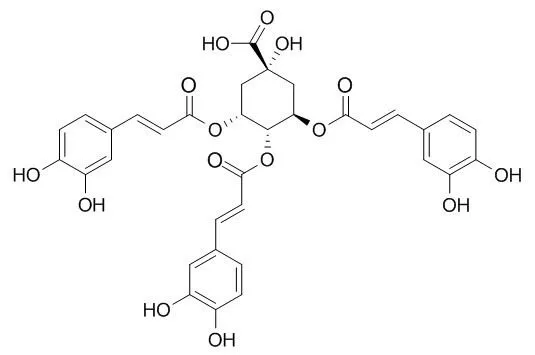| Description: |
3,4,5-Tricaffeoylquinic acid may attenuate the TNF-α- and LPS-stimulated production of inflammatory mediators in keratinocytes by suppressing the Toll-like receptor 4 expression-mediated activation of the Akt, ERK and NF-ĸB pathways, it may exert an inhibitory effect against the pro-inflammatory mediator-induced skin disease. 3,4,5-Tricaffeoylquinic acid may attenuate the proteasome inhibitor-induced programmed cell death in PC12 cells by suppressing the activation of the mitochondrial pathway and the caspase-8- and Bid-dependent pathways, the effect be attributed to its inhibitory effect on the formation of reactive oxygen species and depletion of GSH.
|
| In vitro: |
| Int Immunopharmacol. 2011 Nov;11(11):1715-23. | | 3,4,5-Tricaffeoylquinic acid inhibits tumor necrosis factor-α-stimulated production of inflammatory mediators in keratinocytes via suppression of Akt- and NF-κB-pathways.[Pubmed: 21704193] | Keratinocytes may play an important role in the pathogenesis of skin disease in atopic dermatitis. Caffeoyl derivatives are demonstrated to have anti-inflammatory and anti-oxidant effects. However, the effect of 3,4,5-Tricaffeoylquinic acid prepared from Aconium koreanum on the pro-inflammatory cytokine-stimulated keratinocyte responses remains uncertain.
METHODS AND RESULTS:
In human keratinocytes, we investigated the effect of 3,4,5-Tricaffeoylquinic acid on the tumor necrosis factor (TNF)-α-stimulated production of inflammatory mediators in relation to the nuclear factor (NF)-κB and cell signaling Akt, which regulates the transcription genes involved in immune and inflammatory responses. 3,4,5-Tricaffeoylquinic acid inhibited the TNF-α-stimulated production of cytokines (IL-1β and IL-8) and chemokine (CCL17 and CCL27) in keratinocytes. Bay 11-7085 (an inhibitor of NF-κB activation) and Akt inhibitor attenuated the TNF-α-induced formation of inflammatory mediators. 3,4,5-Tricaffeoylquinic acid, Bay 11-7085, Akt inhibitor and N-acetylcysteine inhibited the TNF-α-induced activation of NF-κB, activation of Akt, and formation of reactive oxygen and nitrogen species. The results show that 3,4,5-Tricaffeoylquinic acid seems to attenuate the TNF-α-stimulated inflammatory mediator production in keratinocytes by suppressing the activation of Akt and NF-κB pathways which may be mediated by reactive oxygen species.
CONCLUSIONS:
The findings suggest that 3,4,5-Tricaffeoylquinic acid may exert an inhibitory effect against the pro-inflammatory mediator-induced skin disease. | | Pharmacology. 2012;90(3-4):183-92. | | 3,4,5-tricaffeoylquinic Acid inhibits the lipopolysaccharide-stimulated production of inflammatory mediators in keratinocytes.[Pubmed: 22947851 ] | Microbial product lipopolysaccharide (LPS) has been shown to be involved in the pathogenesis of inflammatory skin diseases. Caffeoyl derivatives have demonstrated anti-inflammatory and antioxidant effects. However, the effect of 3,4,5-Tricaffeoylquinic acid (3,4,5-triCQA) on the production of microbial product-induced inflammatory mediators in keratinocytes has not yet been studied.
METHODS AND RESULTS:
Using human keratinocytes, we investigated the effect of 3,4,5-Tricaffeoylquinic acid on the LPS-stimulated production of inflammatory mediators in relation to the nuclear factor (NF)-ĸB, Akt and ERK pathways. 3,4,5-Tricaffeoylquinic acid inhibited the LPS-induced expression of Toll-like receptor 4, and the production of cytokines and chemokines in keratinocytes. 3,4,5-Tricaffeoylquinic acid, Bay 11-7085, Aĸt inhibitor and ERK inhibitor each attenuated the LPS-induced production of inflammatory mediators by inhibiting the NF-ĸB, Akt and ERK pathways.
CONCLUSIONS:
3,4,5-Tricaffeoylquinic acid may attenuate the LPS-stimulated production of inflammatory mediators in keratinocytes by suppressing the Toll-like receptor 4 expression-mediated activation of the Akt, ERK and NF-ĸB pathways. 3,4,5-Tricaffeoylquinic acid may exert a preventive effect against microbial product-induced inflammatory skin diseases. |
|
| In vivo: |
| Aging (Albany NY) . 2019 Jan 17;11(2):401-422. | | 3,4,5-Tricaffeoylquinic acid induces adult neurogenesis and improves deficit of learning and memory in aging model senescence-accelerated prone 8 mice[Pubmed: 30654329] | | Abstract
Caffeoylquinic acid (CQA) is a natural polyphenol with evidence of antioxidant and neuroprotective effects and prevention of deficits in spatial learning and memory. We studied the cognitive-enhancing effect of 3,4,5-Tricaffeoylquinic acid (TCQA) and explored its cellular and molecular mechanism in the senescence-accelerated mouse prone 8 (SAMP8) model of aging and Alzheimer's disease as well as in human neural stem cells (hNSCs). Mice were fed with 5 mg/kg of TCQA for 30 days and were tested in the Morris water maze (MWM). Brain tissues were collected for immunohistochemical detection of bromodeoxyuridine (BrdU) to detect activated stem cells and newborn neurons. TCQA-treated SAMP8 exhibited significantly improved cognitive performance in MWM compared to water-treated SAMP8. TCQA-treated SAMP8 mice also had significantly higher numbers of BrdU+/glial fibrillary acidic protein (GFAP+) and BrdU+/Neuronal nuclei (NeuN+) cells in the dentate gyrus (DG) neurogenic niche compared with untreated SAMP8. In hNSCs, TCQA induced cell cycle arrest at G0/G1, actin cytoskeleton organization, chromatin remodeling, neuronal differentiation, and bone morphogenetic protein signaling. The neurogenesis promoting effect of TCQA in the DG of SAMP8 mice might explain the cognition-enhancing influence of TCQA observed in our study, and our hNSCs in aggregate suggest a therapeutic potential for TCQA in aging-associated diseases.
Keywords: BMP signaling; SAMP8; TCQA; neurogenesis; spatial learning and memory. |
|






 Cell. 2018 Jan 11;172(1-2):249-261.e12. doi: 10.1016/j.cell.2017.12.019.IF=36.216(2019)
Cell. 2018 Jan 11;172(1-2):249-261.e12. doi: 10.1016/j.cell.2017.12.019.IF=36.216(2019) Cell Metab. 2020 Mar 3;31(3):534-548.e5. doi: 10.1016/j.cmet.2020.01.002.IF=22.415(2019)
Cell Metab. 2020 Mar 3;31(3):534-548.e5. doi: 10.1016/j.cmet.2020.01.002.IF=22.415(2019) Mol Cell. 2017 Nov 16;68(4):673-685.e6. doi: 10.1016/j.molcel.2017.10.022.IF=14.548(2019)
Mol Cell. 2017 Nov 16;68(4):673-685.e6. doi: 10.1016/j.molcel.2017.10.022.IF=14.548(2019)